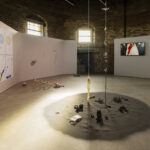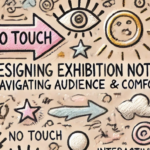To Haonan:
Starting from the second week’s post, you have explored the theme of ‘death’ from various angles. For example, in Week 2, you analysed the 2011 Guangdong Museum of Art exhibition ‘Infinitely Close to the Horizon’ and the 2006 Damien Hirst exhibition ‘The Death of God’ in Mexico, demonstrating an understanding of the theme of death in different cultural contexts. Understanding. The fifth week’s post reflects on a recent visit to the exhibition ‘Sisters!’ (curated by Petra Bauer) and explores how this deepening of curatorial thinking can be extended from the individual’s experience of death to the level of collective memory.
Each blog post has a clear weekly theme and intuitive headings, such as ‘Week 3: The Ephemeral Palette – Exploring the Colors of Death’, allowing readers to quickly understand the focus of each week’s discussion. Subheadings and paragraph breaks are used to ensure that the content is clearly structured and easy to read and understand. Images related to the topic, such as photographs of the exhibition site, were used to enhance the visual appeal of the blog post. The blog posts contain your personal experiences and reflections as well as incorporating academic analyses, reflecting the integration of theory and practice.
However, the logical connection between Week 2, which explored the death exhibition, and Week 3, which turned to materiality and colour, was not clear enough. How does Hirst transition from the symbolism of death to materiality? How does this influence your curatorial interest in colour and ephemeral materials?
To Shumiao:
Your blog demonstrates a strong thematic coherence within the curatorial framework of self-exploration, gender issues and time poverty. The overall content demonstrates your in-depth consideration of theoretical perspectives, feminist discourses and contemporary curatorial approaches. Your blog shows the evolution of curatorial themes from self-exploration (Week 1) → East Asian women’s experiences (Week 2) → women’s time poverty (Week 3), demonstrating the gradual deepening of your research. Week 2 discusses the shift from individual experience to a perspective of socially structured inequality, a shift that makes your curatorial stance more critical and structured. Week 4 reflects on Gabrielle Goliath’s work Personal Accounts, which emphasises the feminist curatorial idea of ‘silence as resistance’, rather than being centred solely on victim narratives. You could go on and on: how does self-exploration evolve into a critique of women’s time poverty? How do individual experiences reflect wider social structures? Exploring how feminist curation is both a process of self-exploration and a political critique at the same time, I hope this will be helpful.
The blog is mostly centred around individual artworks, but there are fewer case studies of full curatorial projects, so I would recommend adding more systematic examples of curatorial feminist curatorial projects and exhibitions of East Asian feminist art.





